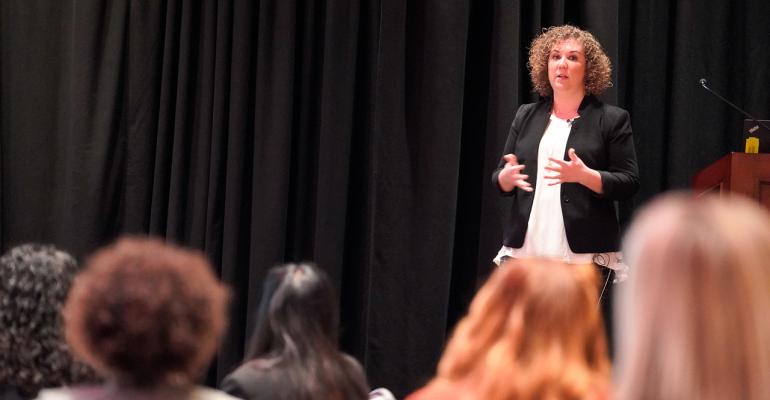In an era when picking up the phone to have a conversation is becoming less common, Shannon Lindgren is dead set against that trend, and she's encouraging other medical- and pharmaceutical-meeting planners to push against the tide as well.
Because planning events for healthcare professionals involves not only hard-and-fast rules but also important corporate-culture considerations that aren't necessarily in writing, "building relationships internally and externally is the most important thing," Lindgren told event planners in attendance at Pharma Forum 2019, held March 24 to 27 in New York co-hosted by CBI and MeetingsNet.
As senior manager of meeting planning for Allergan, Lindgren, CMP, HMCC, oversees educational events for many of the firm's 17,000 employees worldwide as well as for thousands of HCPs who rely on clinical meetings to learn about specific diseases and the latest advances in treatment. In her Pharma Forum session titled "Walking the Tightrope of Clinical Meetings: Achieving the delicate balance of offering value while maintaining compliance," she stressed that while "I live for process—defining it and having everyone follow it—getting my planners to work well with internal stakeholders, third parties, venues, and HCPs to stay in compliance requires nuanced dialogue that's best done over the phone rather than with email."
When Process and Dialogue Intersect, Good Things Happen
Over the past several years, Lindgren has played a major role in developing Allergan's internal processes for servicing event requests that come from the firm's many business units. Her most recent project was to develop all the processes for an R&D division that came into the fold through an acquisition. "They didn't know anything about compliance and approval processes," she said. "We had to start from scratch with them."
At Allergan, each event process begins with Lindgren's team receiving requests from each division through the Cvent online tool. But shortly thereafter, a planner picks up the phone to speak to the internal stakeholder about a specific meeting's objectives, critical needs, and preferences, plus the potential cities and venues that fit the meeting's specs, budget, and compliance requirements. "The stakeholder chooses the venue, not us," she stresses at the start of each conversation. Once that choice is made, her team liaisons with the venue and with third parties regarding the event's logistical elements.
Lindgren's overarching goal for phone conversations: "I simply want the study teams to feel comfortable with me and my colleagues so that they ask us any and every question they might have. We need them to understand how much we can do to help them with their meetings. Using the phone is worth the effort, even if we must summarize the conversation later in an email. It not only lets us cover more details quickly and clearly, but it also helps build their trust in us that we want to learn their specific needs and then explain exactly what we can do for them."
Especially with compliance issues, actual dialogue achieves more in less time than what would surely become an endless email thread. "Perception is so important in making decisions," she said. For instance, "does everyone understand your company's definition of 'modest and reasonable?' And what does your firm consider 'proximity of corruptible influence?'"
Lindgren told Pharma Forum attendees that Allergan uses both HealthCareVenues.com and the Travel Weekly index ratings as their main tools for compliance acceptability for events. Specifically, properties and destinations that score at or below 7 on Allergan's internally-created scale are acceptable for HCP events, while those that score 8 or higher require an exception to be approved by the compliance team. However, Lindgren makes sure to tell internal clients who really want to use a certain property or destination whether or not "the company uses those destinations and properties frequently enough that the effort to get an exception is worthwhile" if it would make a notable difference in attendance. On the other hand, "what elements in that preferred destination can lure attendees away from sessions?" she asks. "And are there properties far enough from the distractions to justify the destination?"
Other Critical Guidance for Internal Clients
Two of the biggest sticking points Lindgren's Allergan colleagues face—and her planning team addresses in phone conversations with them—as they put together their events: Meal caps and surprise guests. First, "while you must know your attendees and obey their meal caps, each venue can help you offer variety," she said. What's more, "taking HCP groups off property for meals is very well received by attendees, especially on the first night because it gets people to interact more across the entire meeting. And compliance is usually fine with that—and it's more cost-effective—when you're off site but within walking distance."
As for surprise guests at meal functions, "we just have to keep reminding HCPs that guests are on their own and cannot take part in the event agenda at all," Lindgren said. "Even though that's made clear to attendees multiple times, we stress to our internal clients that they simply must do the reminding politely, each and every time."





